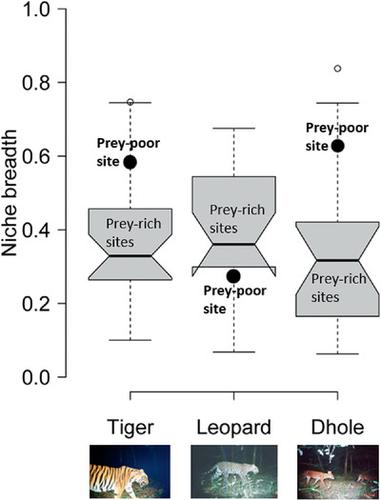当前位置:
X-MOL 学术
›
Integr. Zool.
›
论文详情
Our official English website, www.x-mol.net, welcomes your
feedback! (Note: you will need to create a separate account there.)
The effects of prey depletion on dietary niches of sympatric apex predators in Southeast Asia.
Integrative Zoology ( IF 3.5 ) Pub Date : 2020-07-06 , DOI: 10.1111/1749-4877.12461 Robert Steinmetz 1 , Naret Seuaturien 1 , Pairoj Intanajitjuy 2 , Pichet Inrueang 2 , Kittipat Prempree 2
Integrative Zoology ( IF 3.5 ) Pub Date : 2020-07-06 , DOI: 10.1111/1749-4877.12461 Robert Steinmetz 1 , Naret Seuaturien 1 , Pairoj Intanajitjuy 2 , Pichet Inrueang 2 , Kittipat Prempree 2
Affiliation

|
Resource depletion exerts opposing pressures on co‐occurring consumers to expand diets while limiting overlap with competitors. Using foraging theory as a framework, we tested the effects of prey availability on diet specialization and overlap among competing Asian predators: dhole, leopard, and tiger. We used scat analysis from a prey‐poor site, combined with a quantitative synthesis of 40 other diet studies, to determine biomass of different prey types consumed by each predator. We then assessed diet composition in relation to prey density, and compared diet breadth and overlap between prey‐poor and prey‐rich sites. In prey rich areas, all three predators specialized on energetically profitable medium and large ungulates (>30 kg), resulting in narrow, overlapping niches. Each predator shifted toward less profitable small‐bodied prey (≤30 kg) as preferred ungulates declined, whereas consumption of preferred ungulates was unrelated to small prey abundance, as predicted by foraging theory. Diet breadths doubled under prey depletion (except leopard), but overlap declined as diets diverged via species‐specific traits that facilitated capture of different types of alternative prey. Asia's apex predators adapt similarly to depletion of mutually preferred ungulates by switching to more numerous but less profitable small prey. Yet they can also partition a depleted prey base through intrinsic niche differences, thereby avoiding competitive exclusion. Our findings illuminate the stabilizing properties of adaptive foraging and niche differences in ecological communities, and provide insights into the behavior and resilience of Asia's endangered apex predators in response to prey depletion in the heavily poached forests of this region.
中文翻译:

猎物枯竭对东南亚同胞天敌捕食者饮食生态位的影响。
资源枯竭对同时出现的消费者施加了相反的压力,要求他们扩大饮食结构,同时限制与竞争对手的重叠。使用觅食理论作为框架,我们测试了猎物可食性对饮食专业化的影响以及亚洲竞争性捕食者之间的重叠:洞,豹和老虎。我们使用了捕食少的地点的粪便分析,并结合了40项其他饮食研究的定量合成,来确定每个捕食者消耗的不同猎物类型的生物量。然后,我们评估了与猎物密度相关的饮食组成,并比较了食物稀少和食物丰富的地点之间的饮食广度和重叠程度。在猎物丰富的地区,所有三种捕食者都专门捕捞能赚钱的中型和大型有蹄类动物(> 30公斤),导致狭窄,重叠的生态位。正如觅食理论所预测的那样,随着有蹄类动物的有蹄类动物的数量减少,每个捕食者都转向利润较低的小体类猎物(≤30 kg),而有食性有蹄类动物的消费与小的猎物丰度无关。在猎物耗尽的情况下(豹子除外),饮食宽度增加了一倍,但随着饮食因特定物种的性状而分化,从而促进捕获不同类型的替代性猎物,重叠度下降。亚洲的先头天敌以类似的方式适应了相互偏爱的有蹄类动物的枯竭,转向了数量更多但利润较低的小猎物。然而,它们还可以通过内在的利基差异来划分耗尽的猎物基地,从而避免竞争排斥。我们的发现阐明了生态社区中适应性觅食和生态位差异的稳定特性,
更新日期:2020-07-06
中文翻译:

猎物枯竭对东南亚同胞天敌捕食者饮食生态位的影响。
资源枯竭对同时出现的消费者施加了相反的压力,要求他们扩大饮食结构,同时限制与竞争对手的重叠。使用觅食理论作为框架,我们测试了猎物可食性对饮食专业化的影响以及亚洲竞争性捕食者之间的重叠:洞,豹和老虎。我们使用了捕食少的地点的粪便分析,并结合了40项其他饮食研究的定量合成,来确定每个捕食者消耗的不同猎物类型的生物量。然后,我们评估了与猎物密度相关的饮食组成,并比较了食物稀少和食物丰富的地点之间的饮食广度和重叠程度。在猎物丰富的地区,所有三种捕食者都专门捕捞能赚钱的中型和大型有蹄类动物(> 30公斤),导致狭窄,重叠的生态位。正如觅食理论所预测的那样,随着有蹄类动物的有蹄类动物的数量减少,每个捕食者都转向利润较低的小体类猎物(≤30 kg),而有食性有蹄类动物的消费与小的猎物丰度无关。在猎物耗尽的情况下(豹子除外),饮食宽度增加了一倍,但随着饮食因特定物种的性状而分化,从而促进捕获不同类型的替代性猎物,重叠度下降。亚洲的先头天敌以类似的方式适应了相互偏爱的有蹄类动物的枯竭,转向了数量更多但利润较低的小猎物。然而,它们还可以通过内在的利基差异来划分耗尽的猎物基地,从而避免竞争排斥。我们的发现阐明了生态社区中适应性觅食和生态位差异的稳定特性,











































 京公网安备 11010802027423号
京公网安备 11010802027423号